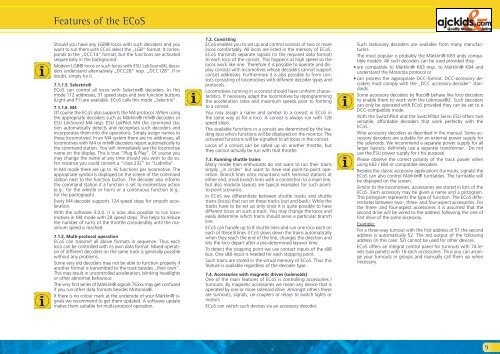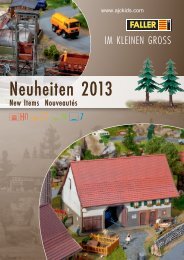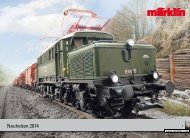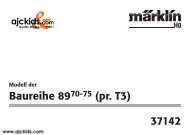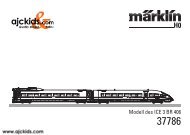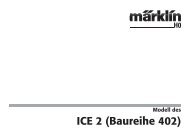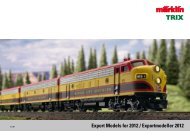User Manual - Ajckids.com
User Manual - Ajckids.com
User Manual - Ajckids.com
You also want an ePaper? Increase the reach of your titles
YUMPU automatically turns print PDFs into web optimized ePapers that Google loves.
Features of the ECoS<br />
Should you have any LGB® locos with such decoders and you<br />
want to run them with ECoS select the „LGB” format. It corresponds<br />
to the „DCC14” format, but the functions are activated<br />
sequentially in the background.<br />
Modern LGB® locos or such locos with ESU LokSoundXL decoders<br />
understand alternatively „DCC28” resp. „DCC128”. If in<br />
doubt, simply try it.<br />
7.1.1.5. Selectrix®<br />
ECoS can control all locos with Selectrix® decoders. In this<br />
mode 112 addresses, 31 speed steps and two function buttons<br />
(Light and F1) are available. ECoS calls this mode „Selectrix“.<br />
7.1.1.6. M4<br />
Of course the ECoS also supports the M4 protocol. When using<br />
the appropriate decoders such as Märklin® mfx® decoders or<br />
ESU LokSound M4 resp. ESU LokPilot M4 the <strong>com</strong>mand station<br />
automatically detects and recognises such decoders and<br />
incorporates them into the operations. Simply assign names to<br />
these lo<strong>com</strong>otives! In an M4 system there are no addresses; all<br />
lo<strong>com</strong>otives with M4 or mfx® decoders report automatically to<br />
the <strong>com</strong>mand station. You will immediately see the lo<strong>com</strong>otive<br />
name on the display. This is true “Plug & Play”. Of course you<br />
may change the name at any time should you wish to do so.<br />
For instance you could convert a “class 232” to “Ludmilla“.<br />
In M4 mode there are up to 16 functions per lo<strong>com</strong>otive. The<br />
appropriate symbol is displayed on the screen of the <strong>com</strong>mand<br />
station next to the function button. The decoder also informs<br />
the <strong>com</strong>mand station if a function is set to momentary action<br />
(e.g.: for the whistle or horn) or a continuous function (e.g.:<br />
for the pantograph).<br />
Every M4 decoder supports 124 speed steps for smooth acceleration.<br />
With the software 3.0.0. it is now also possible to run lo<strong>com</strong>otives<br />
in M4 mode with 28 speed steps. This helps to reduce<br />
the number of turns of the throttle considerably until the maximum<br />
speed is reached.<br />
7.1.2. Multi-protocol operation<br />
ECoS can transmit all above formats in sequence. Thus each<br />
loco can be controlled with its own data format. Mixed operation<br />
of different decoders on the same track is generally possible<br />
without any problems.<br />
Some very old decoders may not be able to function properly if<br />
another format is transmitted to the track besides „their own”.<br />
This may result in uncontrolled acceleration, blinking headlights<br />
or other abnormal behaviour.<br />
The very first series of Märklin® signals 763xx may get confused<br />
if you run other data formats besides Motorola®.<br />
If there is no colour mark at the underside of your Märklin® signals<br />
we re<strong>com</strong>mend to get them updated. A software update<br />
makes them suitable for multi-protocol operation.<br />
7.2. Consisting<br />
ECoS enables you to set up and control consists of two or more<br />
locos <strong>com</strong>fortably. All locos are listed in the memory of ECoS.<br />
ECoS transmits separate signals (in the required data format)<br />
to each loco of the consist. This happens at high speed so the<br />
locos work like one. Therefore it is possible to operate and display<br />
consists with lo<strong>com</strong>otives whose decoders cannot support<br />
consist addresses. Furthermore it is also possible to form consists<br />
consisting of lo<strong>com</strong>otives with different decoder types and<br />
protocols.<br />
Lo<strong>com</strong>otives running in a consist should have uniform characteristics.<br />
If necessary adapt the lo<strong>com</strong>otives by reprogramming<br />
the acceleration rates and maximum speeds prior to forming<br />
to a consist.<br />
You may assign a name and symbol to a consist in ECoS in<br />
the same way as for a loco. A consist is always run with 128<br />
speed steps.<br />
The available functions in a consist are determined by the leading<br />
loco who’s functions will be displayed on the monitor. The<br />
activated functions will be signalled to all locos in the consist.<br />
Locos of a consist can be called up on another throttle, but<br />
they cannot actually be run with that throttle.<br />
7.3. Running shuttle trains<br />
Many model train enthusiasts do not want to run their trains<br />
simply „in circles“ but want to have real point-to-point operation.<br />
Branch lines onto mountains with terminal stations at<br />
either end, small branch lines with a connection to a main line,<br />
but also modular layouts are typical examples for such pointto-point<br />
scenarios.<br />
In ECoS we differentiate between shuttle tracks and shuttle<br />
trains (locos) that run on these tracks (out and back). While the<br />
tracks have to be set up only once it is quite possible to have<br />
different locos on such a track. You may change the locos and<br />
easily determine which trains should serve a particular branch<br />
line.<br />
ECoS can handle up to 8 shuttle lines and run one loco each on<br />
each of these 8 lines. ECoS slows down the trains automatically<br />
when they reach the end of the line, changes the direction and<br />
lets the loco depart after a pre-determined layover time.<br />
To detect the stopping point we use contact inputs of the s88<br />
bus. One s88-input is needed for each stopping point.<br />
Such trains are stored in the virtual memory of ECoS. Thus this<br />
feature is available regardless of the decoder type.<br />
7.4. Accessories with magnetic drives (solenoids)<br />
One of the main features of ECoS is controlling accessories /<br />
turnouts. By magnetic accessories we mean any device that is<br />
operated by one or more solenoid drive. Amongst others these<br />
are turnouts, signals, un-couplers or relays to switch lights or<br />
motors.<br />
ECoS can switch such devices via an accessory decoder.<br />
Such stationary decoders are available from many manufacturers.<br />
The most popular is probably the Märklin® K83 ands <strong>com</strong>patible<br />
models. All such decoders can be used provided they<br />
• are <strong>com</strong>patible to Märklin® K83 resp. to Märklin® K84 and<br />
understand the Motorola protocol or<br />
• can process the appropriate DCC-format. DCC-accessory decoders<br />
must <strong>com</strong>ply with the „DCC accessory decoder“ standards.<br />
Some accessory decoders by Roco® behave like loco decoders<br />
to enable them to work with the Lokmaus®2. Such decoders<br />
can only be operated with ECoS provided they can be set to a<br />
DCC-<strong>com</strong>patible mode.<br />
With the SwitchPilot and the SwitchPilot Servo ESU offers two<br />
versatile, affordable decoders that work perfectly with the<br />
ECoS.<br />
Wire accessory decoders as described in the manual. Some accessory<br />
decoders are suitable for an external power supply for<br />
the solenoids. We re<strong>com</strong>mend a separate power supply for all<br />
larger layouts: definitely use a separate transformer. Do not<br />
use the ESU power supply for t his purpose.<br />
Please observe the correct polarity of the track power when<br />
using k83 / k84 or <strong>com</strong>patible decoders.<br />
Besides the classic accessory applications (turnouts, signals) the<br />
ECoS can also control Märklin® turntables. The turntable will<br />
be displayed on the screen.<br />
Similar to the lo<strong>com</strong>otives, accessories are stored in lists of the<br />
ECoS. Each accessory may be given a name and a pictogram.<br />
This pictogram represents the type of function. The ECoS differentiates<br />
between two-, three- and four-aspect accessories. For<br />
the three- and four-aspect accessories it is assumed that the<br />
second drive will be wired to the address following the one of<br />
first drive of the same accessory.<br />
Example:<br />
For a three-way turnout with the first address of 51 the second<br />
address is automatically 52. The red output of the following<br />
address (in this case: 52) cannot be used for other devices.<br />
ECoS offers an integral control panel for turnouts with 74 levels<br />
(sub panels) with 16 each accessories. Thus you can arrange<br />
your turnouts in groups and manually call them up when<br />
necessary.<br />
9


